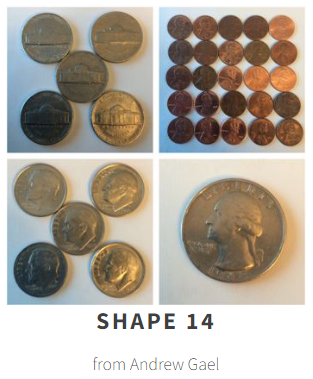- MN ABE Connect
- Archive
- Routines That Foster Constructing Viable Arguments and Critiquing the Reasoning of Others – Part 2
 September 26, 2022
September 26, 2022
Routines That Foster Constructing Viable Arguments and Critiquing the Reasoning of Others – Part 2
Lindsey Pust, Numeracy & Special Projects CoordinatorIn Part 1 of this article, we examined why routines in general and math routines specifically are a critical component of ALL adult education instruction, whether the context is a math class or not. Check out that article to learn about a great routine called Fraction Talks, which is #1 of 3 routines being presented here.
In this article, we will explore 2 additional math routines that you can use with your students.
Routine 2: Which One Doesn’t Belong? (or WODB)
Description: WODB is another great 10-15 minute routine that encourages students to look for patterns and relationships and then share their reasoning with others with no wrong answer! A true WODB prompt is constructed so that there are multiple valid answers.

You try! How would you answer this question: Which one doesn’t belong?
- Did anyone say the quarter because it is all by itself?
- How about the nickels because they are the only ones showing tails?
- Or the pennies because they are the only copper coins?
- Or perhaps you said the dimes because they show 50 cents and not 25 cents like the others?
- Or maybe you thought of an entirely different reason why one square doesn’t belong!
As you can see, there are multiple answers and ample opportunity for speaking and listening, creating and defending arguments, critiquing others’ reasoning—and developing numeracy skills—yet again!
Adaptations:
- Just like with the fraction talks, students can interact with other students, a teacher/volunteer, or on paper. Provide sentence frames to help students construct and defend their argument and critique the reasoning of other classmates or other statements provided by the teacher.
- Post a WODB image each week in the classroom or on your class website. Provide a way for students to respond and interact with other arguments, even if not in “real-time.”
Resource:
- WODB prompts (shapes, graphs, numbers)
Routine 3: Always, Sometimes, Never
Description: Students read a statement and decide whether it is always true, sometimes true, or never true. Students have to defend their reasoning with logic and examples. Again, this can be a 10-15 minute routine.
Consider this statement:
A city’s population decreased by 10% in the last two years. A town’s population increased by 5% within the same timeframe. So there are more people living in the town than in the city.
- Is this always true? Sometimes true? Never true? How do you know?
Or this statement:
Multiplying one number by another number results in a larger number.
- Always true? Sometimes true? Never true? How do you know?
Can you start to see the richness of a routine like this? It takes minimal prep time and will create opportunities for formative assessment, rich conversation, practice choosing precise language, and using evidence as support.
Adaptations:
- Provide the same supports and adaptations described for the fraction talks and WODB.
- Provide targeted vocabulary support to help with precise language.
- Have students write or draw their reasoning before sharing with the class, teacher, or partner.
- Have students summarize what a partner said and share whether they agree or disagree with their reasoning and why. If students are in a one-room schoolhouse setting, provide an argument for them to respond to.
- Post a statement each week in the classroom or on your class website. Provide a way for students to respond and interact with other statements, even if not in “real-time”.
- Have students use a Jamboard or other online tool to share their reasoning.
Resource:
- The University of Cambridge has a website with more example statements you can use in your classroom.
- Use these pre-made statements to match your current instructional content, or create your own!
- Create an activity sort (on Jamboard or with paper!) with several statements, or choose one statement a week/unit for students to grapple with.
Additional resources
- If you are working with students at the pre-algebra/algebra level, consider using some of these pre-made prompts (source: https://emergentmath.com/algebra-warm-ups-for-geometry-teachers/). There are actually enough warm-ups shared in this resource for an entire school year! You will see some familiar routine names among the prompts shared in this resource: fraction talks, WODB, and always-sometimes-never. There are Google slides and Google doc versions already made. Pick the ones that make sense for your classroom, and use a variety of routine types or stick with the same routine.
- Don’t forget about the Numeracy resource library on the ATLAS website, where you will find the resources we’ve highlighted here in addition to many others categorized under Content Resources and Instructional Resources.
And remember, whatever you take away from this article—one nugget or many—the more familiar a routine becomes, the easier it will be for students to focus on formulating and articulating their arguments and critique others’ reasoning.
Newsletter Signup
Get MN ABE Connect—the official source for ABE events, activities, and resources!
Sign UpArticle Categories
- ABE Foundations/Staff Onboarding
- ACES/Transitions
- Adult Career Pathways
- Assessment
- CCR Standards
- Citizenship
- COVID-19
- Cultural Competency
- Digital Literacy/Northstar
- Disabilities
- Distance Learning/Education
- ELA
- Equity/Inclusion
- ESL
- HSE/Adult Diploma
- Listening
- Math/Numeracy
- Mental Health
- Minnesota ABE
- One-Room Schoolhouse/Multilevel
- Professional Development
- Program Management
- Reading
- Remote Instruction
- Science
- Social Studies
- Speaking/Conversation
- Support Services
- Teaching Strategies
- Technology
- Uncategorized
- Volunteers/Tutors
- Writing